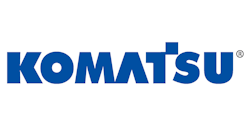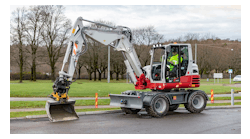Versatility is most often the name of the game when it comes to attachments. Cathy DeSanto is the Operations Manager for Alpine Equipment. She explains that their Rockwheel rock and concrete grinders are used by a wide variety of contractors from smaller owner operators to large international tunneling firms. “And since the applications for this attachment vary so widely, the types of contractors also vary quite a bit—from underground limestone mines to concrete rehab companies to utility trench contractors and even soil stabilization outfits,” says DeSanto. She adds that the primary applications are concrete scaling, trenching, mining/tunneling, and soil mixing.
A number of Alpine’s customers buy more than just one attachment. Some of their larger quarry and mining customers buy multiple units to increase production. And according to DeSanto, “a contractor that buys a larger Rockwheel, for example, might see that having a smaller one on hand for a smaller excavator in their fleet would also be beneficial.”
Versatility is most often the name of the game when it comes to attachments. Cathy DeSanto is the Operations Manager for Alpine Equipment. She explains that their Rockwheel rock and concrete grinders are used by a wide variety of contractors from smaller owner operators to large international tunneling firms. “And since the applications for this attachment vary so widely, the types of contractors also vary quite a bit—from underground limestone mines to concrete rehab companies to utility trench contractors and even soil stabilization outfits,” says DeSanto. She adds that the primary applications are concrete scaling, trenching, mining/tunneling, and soil mixing. A number of Alpine’s customers buy more than just one attachment. Some of their larger quarry and mining customers buy multiple units to increase production. And according to DeSanto, “a contractor that buys a larger Rockwheel, for example, might see that having a smaller one on hand for a smaller excavator in their fleet would also be beneficial.” [text_ad] Alpine Equipment knows their customers want good production rates and a good value. “The Rockwheel can offer precision cutting and reduced need for backfill in trenching operations, so value can come in more ways than just the higher production rates,” says DeSanto. Jonathan Ferguson from Terex Construction Americas says it simply: “Most contractors already have one or more tool carriers in their fleet.” This could be anything from compact utility loaders, skid-steer loaders, compact track loaders, and wheel loaders, to backhoe loaders or telehandlers. “These multi-use loaders can provide a significant savings to any contractor’s business by eliminating the need for various dedicated specialty machines.” He pointed out that when equipped with a universal quick-attach system, loaders offer versatility and ease of use, and, because attachments can be changed out relatively quickly—often times by simply turning two locking pins and connecting hydraulic lines—using a loader as a multipurpose landscaping tool enhances productivity and efficiency. Buckets, augers, trenchers, vibratory plows, breakers, backhoes, levelers, tillers, cultivators, forks, blades, brush hogs or saws, land planes, and rakes are the attachments most commonly associated with landscaping projects. And by adding rotary brooms and snow blowers to a contractor’s fleet, a seasonal business is able to easily expand, offering service on a year-round basis. “Manufacturers, such as Terex, offer a variety of attachment options for the compact lines of [their] construction equipment to increase the versatility and utilization of these machines,” says Ferguson. “We’ve had customers say that their attachments will basically pay for themselves in one season with the number of jobs they bring in. Then they’ll have that piece of equipment forever, and will continue to profit from it with the additional jobs. For customers who were watching their bottom lines in the down construction economy, attachments are cheaper than buying a new machine. It allows them to be more job-specific, while at the same time giving them more options with their current equipment.” Attachments for production work need to have both durability and power for repeat applications, and they need to match the loader’s horsepower and hydraulic capabilities. “It is a good idea to source your attachments through the distributorship where you purchased your equipment,” says Ferguson. “Your distributor knows the machine’s exact hydraulic specifications and will counsel you on which attachments will work with your unit. It is important to let your distributor know all of the potential applications you want to perform, because this will influence what advice your distributor gives to you when making a machine purchase.” [text_ad use_post='27747'] Ferguson adds that “contractors are always looking for ways to increase revenue with their current machinery inventories. Attachments are the best way to keep overhead in line for owners and operators.” Attachments can turn one machine into a multipurpose tool. New attachments are coming along every day, and contractors should be on the lookout for new products that make their job more efficient. Adding attachments to perform profitable tasks is always a good financial decision, simply because they cost relatively little compared to the revenue stream they can see as a result of performing more tasks on the job site. For this reason he says, “One way savvy business owners can better manage their fleet inventories versus cost of equipment acquisition is to think outside of the box when it comes to equipment offerings and utilization.”Alpine Equipment knows their customers want good production rates and a good value. “The Rockwheel can offer precision cutting and reduced need for backfill in trenching operations, so value can come in more ways than just the higher production rates,” says DeSanto.
Jonathan Ferguson from Terex Construction Americas says it simply: “Most contractors already have one or more tool carriers in their fleet.” This could be anything from compact utility loaders, skid-steer loaders, compact track loaders, and wheel loaders, to backhoe loaders or telehandlers. “These multi-use loaders can provide a significant savings to any contractor’s business by eliminating the need for various dedicated specialty machines.” He pointed out that when equipped with a universal quick-attach system, loaders offer versatility and ease of use, and, because attachments can be changed out relatively quickly—often times by simply turning two locking pins and connecting hydraulic lines—using a loader as a multipurpose landscaping tool enhances productivity and efficiency.
Buckets, augers, trenchers, vibratory plows, breakers, backhoes, levelers, tillers, cultivators, forks, blades, brush hogs or saws, land planes, and rakes are the attachments most commonly associated with landscaping projects. And by adding rotary brooms and snow blowers to a contractor’s fleet, a seasonal business is able to easily expand, offering service on a year-round basis.
“Manufacturers, such as Terex, offer a variety of attachment options for the compact lines of [their] construction equipment to increase the versatility and utilization of these machines,” says Ferguson. “We’ve had customers say that their attachments will basically pay for themselves in one season with the number of jobs they bring in. Then they’ll have that piece of equipment forever, and will continue to profit from it with the additional jobs. For customers who were watching their bottom lines in the down construction economy, attachments are cheaper than buying a new machine. It allows them to be more job-specific, while at the same time giving them more options with their current equipment.”
Attachments for production work need to have both durability and power for repeat applications, and they need to match the loader’s horsepower and hydraulic capabilities.
“It is a good idea to source your attachments through the distributorship where you purchased your equipment,” says Ferguson. “Your distributor knows the machine’s exact hydraulic specifications and will counsel you on which attachments will work with your unit. It is important to let your distributor know all of the potential applications you want to perform, because this will influence what advice your distributor gives to you when making a machine purchase.”











